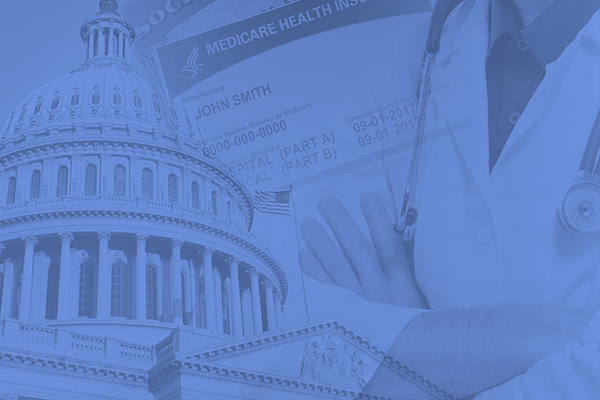
While a one-year, positive payment adjustment is now officially part of the 2026 Medicare physician fee schedule, with conversion factors increasing Medicare pay by as much as 3.77%, Texas Medical Association officials remain concerned the schedule also retains elements with yet another round of negative downstream effects for many already struggling physician practices.
TMA staff continue to analyze the 1,216-page final rule document ahead of briefing physicians. Register for the free Nov. 20 webinar by Nov. 19.
The Centers for Medicare & Medicaid Services (CMS) issued its final rule the afternoon of Oct. 31, providing four different conversion factors that give an extra boost to qualified alternative payment model (APM) participants as envisioned by the 2015 Medicare Access and CHIP Reauthorization Act (MACRA).
Each factor reflects the one-year, 2.5% update mandated through passage of the One Big Beautiful Bill Act (OBBBA), a 0.49% budget neutrality adjustment, plus an additional 0.75% increase for qualifying APM participants and 0.25% increase for nonqualifying APM participants under MACRA.

“That’s a positive for sure, but it still doesn’t match the inflation rate, ”TMA President Jayesh “Jay” Shah, MD, said regarding the one-year pay increase. “If you really look at it, for 20 to 30 years, we have been seeing reductions, so 2.5% really doesn’t cut it. Some physicians may not be able to continue running private practices or even keep the lights on with just a 2.5% increase.
“[Federal officials] have to adjust for the inflation rate, and that’s what we have been asking for, ”Dr. Shah urged, reiterating TMA and the American Medical Association’s long-time advocacy for physician payment updates at least equal to the annual percentage increase in the Medicare Economic Index.
Dr. Shah anticipates that the latest physician fee schedule will be a focus of forthcoming advocacy efforts from AMA, which meets later this month.
TMA joined AMA and myriad specialty and state medical organizations in opposing practice efficiency cuts of 2.5% when they appeared in the proposed rule. While those cuts still exist, they’re impacting about 7,700 services in the final rule, compared to nearly 9,000 in the proposed rule.
The practice efficiency cut directly impacts work relative value units (RVUs), part of the payment equation that, per AMA, measures “a physician’s time, technical skill, mental effort, decision-making, and stress.” An AMA analysis notes CMS did accept 90% of the AMA Relative Value Scale Update Committee’s RVU recommendations.
The final rule also retains a 50% indirect expense cut affecting numerous services performed in facilities such as hospitals and ambulatory surgical centers. AMA estimated physicians working in those families could see payment decrease by 7% overall.
Meanwhile, an ambulatory specialty model program aiming to incentivize specialists for proactive care of chronic conditions will proceed, starting Jan. 1, 2027, and continuing for five years, despite TMA’s concerns that the model is based on “the flawed Merit-Based Incentive Payment System (MIPS)/MIPS Value Pathways (MVP) framework.” The model is mandatory in selected geographic areas, but it’s still unknown if Texas will be included.
Within MIPS, CMS will maintain the performance threshold of 75 points that participating physicians need to reach to avoid up to a 9% penalty through the 2028 performance year (and, subsequently, in 2030 payment). While that provides some welcome stability, TMA maintains its overarching concerns about the viability of MIPS physician participation, particularly for small, independent, and rural physician practices.
While CMS won’t extend the exemption allowing physicians to do telemedicine from home without listing their home address, it is providing instructions on how physicians can suppress their home address from public view on CMS directories. The current exemption ends Dec. 31.
TMA’s Nov. 20 webinar will include details on this and other relevant telemedicine concerns, including the geographic site restrictions that expired Sept. 30 and have not been renewed as of this writing.
Register for the upcoming webinar on the physician fee schedule, and email Cheryl Krhovjak, director of TMA’s Education Center, to submit questions in advance.
How the One Big Beautiful Bill Act (OBBBA) could transform Texas health care
A Mixed Medicaid Bag: Federal changes may narrow certain Medicaid eligibility provisions, boost others
Immigrant Eligibility Provisions: Federal officials approved these new immigrant eligibility provisions for Medicaid, Medicare, and the Affordable Care Act under OBBBA.
Disrupting the Marketplace: How the ACA expiring tax credits could impact health care costs
ACA in Texas: What parts of the state do Texans carry ACA health plans?
Community Support: Texas aims to use federal funding to address rural health care challenges
One Big Beautiful Bill Act changes: Key modifications introduced by the 2025 federal budget bill – known as OBBBA – that affect major health care programs.
Expanded Flexibility: Patients can now pay for direct primary care with health savings accounts – with caveats
Cap at Hand: Federal loan changes could exacerbate medical students’ financial challenges
How other federal budget items could affect Texas
Budget Crunch: Uncertainty besets Texas’ public health infrastructure as federal funding streams dry up
Phil West
Associate Editor
(512) 370-1394
phil.west[at]texmed[dot]org

Phil West is a writer and editor whose publications include the Los Angeles Times, Seattle Times, Austin American-Statesman, and San Antonio Express-News. He earned a BA in journalism from the University of Washington and an MFA from the University of Texas at Austin’s James A. Michener Center for Writers. He lives in Austin with his wife, children, and a trio of free-spirited dogs.